Cambodian Building Boom
Asia's economic basket-case has lately become the region's surprise new tiger, roaring with double-digit growth rates fueling a frenzy of new development projects. As dozens of high-rises reshape a skyline of mostly three-story buildings in the capital of Phnom Penh, Cambodia is experiencing its first construction boom in 1,000 years.
By Ron Gluckman /Phnom Penh, Cambodia
THE ASIAN BOOM, albeit a decade belatedly, has finally arrived in late-bloomer Cambodia, attracting regional investment, and sending property prices skyrocketing.
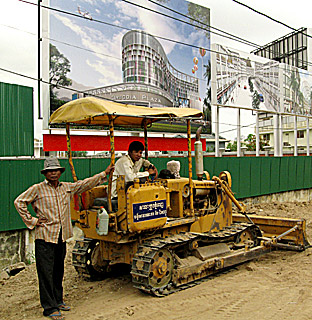 Real estate
prices are soaring in the capital of Phnom Penh, and the south coast around
Sihanoukville, where seaside property is still cheap compared to neighboring
Thailand. Also hot is the northern town of Siem Reap, where a tourism boom and
the popularity of the nearby temples of Angkor Wat have created a
huge market for
hotels, golf courses, art galleries and boutiques catering to one of the world’s
fastest-growing tourist industries.
Real estate
prices are soaring in the capital of Phnom Penh, and the south coast around
Sihanoukville, where seaside property is still cheap compared to neighboring
Thailand. Also hot is the northern town of Siem Reap, where a tourism boom and
the popularity of the nearby temples of Angkor Wat have created a
huge market for
hotels, golf courses, art galleries and boutiques catering to one of the world’s
fastest-growing tourist industries.
Since 1993, when Cambodia had a mere 50,000 foreign visitors, tourism has expanded 40-fold. In 2006, there were 1.6 million visitors, a number projected to top two million this year. Tourism now ranks with top industries of textiles and agriculture. However, the hottest new sector is real estate, which is helping to drive the country’s explosive growth.
Cambodia’s economy grew 9 percent in 2006, according to the World Bank. This was down from the torrid 13.4 percent growth in 2005, but still gave Cambodia Asia’s second fastest-growing economy after China. It was the fifth straight year of growth for Cambodia.
Nowhere is that growth more visible than in the capital of Phnom Penh, where a slew of construction projects are drastically redrawing the skyline and shaking up what has been among the world’s poorest and sleepiest capitals.
Property agents around Phnom Penh say that prices for homes and land have doubled in the last three years. Local real estate prices last year rose 9 percent, Asia’s second-fastest growth rate after China. Most expect even greater gains this year.
“Cambodia
is booming,” says Phatry Derek Pan, an American of Cambodian heritage,
now working in Phnom Penh as a real estate consultant. “Everywhere you
look, there is a new office building or shopping mall under construction.”
Kim Sambo, an agent for C.P.M. Real Estate, says the industry has developed rapidly in the last three years, after a decade of slow or no growth. He recently bought his first home for $10,000, but figures the price has already doubled or tripled, and plans to trade up. “Everybody is doing the same. Real estate is where the money is.”
The greatest growth is seen along the highway west of the capital towards the airport. Cranes are common in fields that hosted only the stray cow just two years ago. Now, vast building sites are topped with signs for future plazas or “Charming Tourist City.”
Numerous projects are underway here, many involving thousands of luxury homes and apartments. Several are self-contained satellite cities, 10-15 kilometers from downtown Phnom Penh, but complete with their own shopping malls, supermarkets, schools, hospitals and hotels.
“Moving out of the city makes sense for many reasons,” says Nhem Sothea, marketing manager for Grand Phnom Penh International City, among the largest projects on the horizon. “This is safe, in a green environment, away from all the noise and traffic of Phnom Penh.”
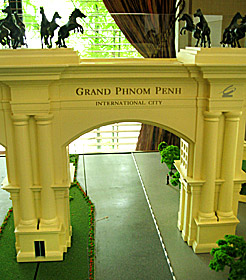 Security in a
crime-riddled society is highlighted in the new developments, as much as modern
styling and convenience. Sothea notes that this gated community will feature
clusters of housing, each with individual guards and separate access permission.
Security in a
crime-riddled society is highlighted in the new developments, as much as modern
styling and convenience. Sothea notes that this gated community will feature
clusters of housing, each with individual guards and separate access permission.
Two-story homes will feature exterior columns and big picture windows, in a models with French names like La Vilette, Versailles, La Fountaine and Monte Carlo. Prices will run to $1 million, according to Sothea.
Site preparation has already begun on a project set to span eight years. The first phase, with 510 homes of a projected build-out of 3800 houses and villas, is set for completion in 2009. There will be an additional 1800 condominiums, as well as several hotels.
Closer to downtown is Plaza Cambodia, which will also include a mix of residential and commercial property. This development features a denser mix of apartment blocks and a style of townhouse called a shop-house, that is common to urban Cambodia.
Shop-houses are a fixture in Chinese areas of Asia. The Cambodian version is often three or four stories, with a business on the ground floor, and housing above. Buildings share walls with adjacent shop-houses, and there is little or no garden space.
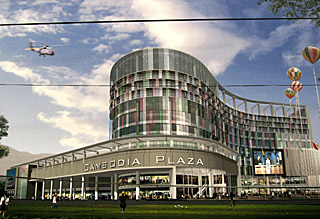 Plaza
Cambodia’s first phase will feature 128 shop-houses, plus a supermarket, a
small hotel and five dozen restaurants in a 10-acre development to be completed
by 2008. Four-story shop-houses will sell for $220,000 to $240,000, while
six-story shop-houses will run up to $670,000, according to Dalim Chlem, a
salesperson for the development.
Plaza
Cambodia’s first phase will feature 128 shop-houses, plus a supermarket, a
small hotel and five dozen restaurants in a 10-acre development to be completed
by 2008. Four-story shop-houses will sell for $220,000 to $240,000, while
six-story shop-houses will run up to $670,000, according to Dalim Chlem, a
salesperson for the development.
The second phase (2008-9) will add much of the plaza development, including another hotel, entertainment complex with two cinemas and a big disco, over 500 shops, and parking on another nearly 10-acre section.
A final 15 acre area is set for a 28-story hotel with 444 rooms and big exhibition area, plus a computer and electronics center, 248 upscale apartments and 900 parking places. This third phase is planned for 2009-2012.
Both projects are funded by big-pocket Indonesian investors. Grand Phnom Penh International City is a project of the Ciputra Group, in partnership with local firm YLP. Plaza Cambodia is a project of Lipo Politan Corporation, which also has a large development underway near Siem Reap.
By far the largest project announced for Phnom Penh is World City, a Korean venture with reported investment of $2 billion. It would be financed entirely by a Korean bank that recently announced rare permission to set up banking operations in Cambodia.
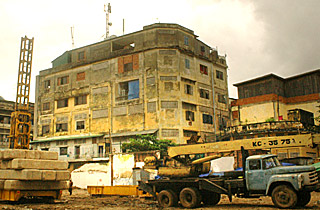 Investment
interest in Cambodia is the reward for relative stability after decades of
fighting that dates back to the Vietnam War and the subsequent rule of the Khmer
Rouge, blamed for the deaths of up to 20 percent of the population in the late
1970s.
Investment
interest in Cambodia is the reward for relative stability after decades of
fighting that dates back to the Vietnam War and the subsequent rule of the Khmer
Rouge, blamed for the deaths of up to 20 percent of the population in the late
1970s.
The comparative lack of development has become, in recent years, an attraction to regional firms, particularly from Vietnam and Thailand, which dominate commercial sectors. China, Taiwan, Singapore, Korea, Japan and Malaysian investors are also becoming active in a nation that many feel has plenty of room to grow.
Oil discovered off Cambodia’s southern coast brings promise of increased revenue flow and affluence in coming years. DHL cut the ribbon on a big office on the airport road early this year, while GE opened a branch office in July. 'This day is merely the first step in what is going to be a long marathon that GE is going to play in Cambodia,' noted Ferdinando Beccalli-Falco, president and executive officer of GE International.
Others are put off by the lack of infrastructure and legal protections in a country that still claims more guns than general stores. The first full-service supermarkets only opened this decade, and Cambodia still claims no international food franchises.
Pizza Company, Thailand’s largest pizza chain, opened two years ago at the Sorya Center, which, although only six stories, was then Cambodia’s tallest building. The view extended for miles in all directions, over uniform three-story blocks.
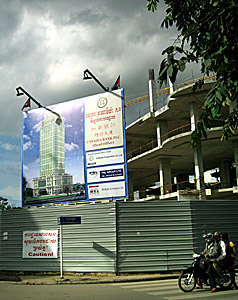 Now, half a
dozen buildings ranging between 20 and 30 stories are under construction, mainly
along Monivong Boulevard. Phan says this has been the scene of the greatest
property speculation, with prices doubling in the last two years.
Now, half a
dozen buildings ranging between 20 and 30 stories are under construction, mainly
along Monivong Boulevard. Phan says this has been the scene of the greatest
property speculation, with prices doubling in the last two years.
Also popular is property skirting the Tonle Sap River, which features some of the city’s finest French colonial architecture. The former grass fields across the river now sprout villas.
Speculation is rampant. Even the government has expressed concerns over a potential bubble, but many believe growth is sustainable due to welling consumer demand and affluence, only now playing catch-up with the rocketing regional growth.
Foreigners are restricted from owning property in Cambodia. As in Thailand, they typically form companies to hold property, with a majority of locals as stakeholders, but the foreigner holding shares with majority rights. Cambodian real estate firms assist with such arrangements, which have never been legally sanctioned.
Real estate remains a risky, although potentially lucrative, investment in a country with a long history of corruption that has been harshly criticized by land watchdogs.
Local publications regularly feature stories about land scandals and mass resettlement. This is common in emerging countries across Asia, most prominently in China, where rapid development has prompted huge relocations, often with violent consequences.
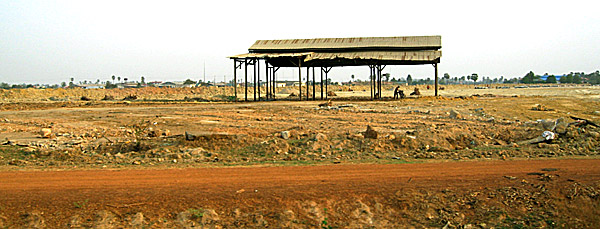
Cambodia suffers regular land battles complicated by the legacy of the Khmer Rouge, who not only emptied cities but shifted practically all the country’s rural populations. Public records were burned along with the national currency. Land deeds have only recently been reintroduced, but remain unknown to poor farmers.
Concessions for prime property are given in backroom deals, without public scrutiny or proper planning. Often the first public recognition of a sale occurs when battles break out as armed troops arrive to clear people from land they have farmed for years.
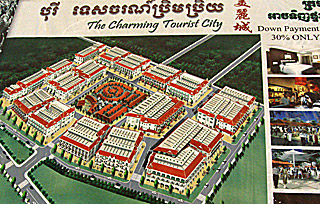 Cambodia also
claims little experience with land planning. So many lakes surrounding and
nurturing the capital for centuries have been filled in by land-hungry
developers that the growing outcry prompted unusual responses from the Prime
Minister Hun Sen.
Cambodia also
claims little experience with land planning. So many lakes surrounding and
nurturing the capital for centuries have been filled in by land-hungry
developers that the growing outcry prompted unusual responses from the Prime
Minister Hun Sen.
Asia’s longest serving leader, and victor of several coups, Hun Sen has regularly sided with development. In June, the folksy PM, vowing to keep power until he’s 90, claimed credit for a property boom that sent prices of bare land to $1 million. “Without me, without my rule, it would be worth only $500,” he told reporters.
In August, he sent bulldozers for yet another land clearing. But this time, demolishing newly-built villas, instead of the squatter villages. The government claimed that Long Ckhin Resorts had illegally filled in Kob Srov Lake for villas and a 10-story hotel. All were knocked down, and the official who signed the deal was sacked.
The news
encouraged advocates of transparent planning and protection of property rights
of the poor. Officially, a third of the population lives under the poverty line.
Hence, it is logical to wonder who will buy $1 million homes at Grand Phnom Penh International City, now a dirt pitch the size of many football fields. Clearly, executives of firms investing in the Cambodian boom will want a modern home and office in a safe, clean environment. Yet Soeth says most buyers are likely to be Cambodian.
“Our planning is all based on the economy growing. Cambodia needs this type of development. The city infrastructure is old,” he notes. “Phnom Penh was built to serve a city of 600,000 people. Now the population is 1.6 million, and growing. Phnom Penh has to expand out. The timing is right.”
Longtime Cambodian resident Anthony Alderson concurs. Manager of the FCCC, or Foreign Correspondent’s Club of Cambodia, which is the country’s top restaurant and watering hole, in a dazzling colonial structure along the Tonle Sap River, he arrived in Cambodia in 1992, and has witnessed various periods of false growth.
“This place is finally taking off,” he says. His company of Hong Kong investors has opened an FCC hotel and shopping complex in Siem Reap, and plans another hotel for downtown Phnom Penh. “This is the time for Cambodia. I can feel it.”
Ron Gluckman is an American reporter who has been living in and covering Asia since 1991. He is currently based in Bangkok, but spends much of his time in Cambodia, where he wrote this piece for the Urban Land Institute, which published it in October 2007.
All pictures by Ron Gluckman.
To return to the opening page and index

push here
[right.htm]